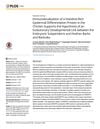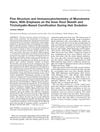Cornification in Reptilian Epidermis Occurs Through the Deposition of Keratin-Associated Beta-Proteins (Beta-Keratins) Onto a Scaffold of Intermediate Filament Keratins
October 2012
in “
Journal of Morphology
”
TLDR Reptile skin hardens by layering beta-proteins on keratin.
The study investigated the process of cornification in reptilian epidermis, focusing on the role of keratin-associated beta-proteins (formerly beta-keratins) and alpha-keratins. Researchers used epitope-specific antibodies to localize these proteins in various reptilian species, including lizards, snakes, tuatara, crocodiles, and turtles. They found that acidic alpha-proteins were present in suprabasal and precorneous layers, while beta-proteins were found in precorneous and corneous layers. This pattern of protein synthesis was similar to that in mammalian epidermis and hair. In turtles and crocodilians, beta-proteins were synthesized in upper spinosus and precorneous layers, accumulating in the corneous layer. The study highlighted the unique ability of sauropsid beta-proteins to form filaments and an X-ray beta-pattern, a feature not observed in other vertebrates' keratin-associated proteins.




